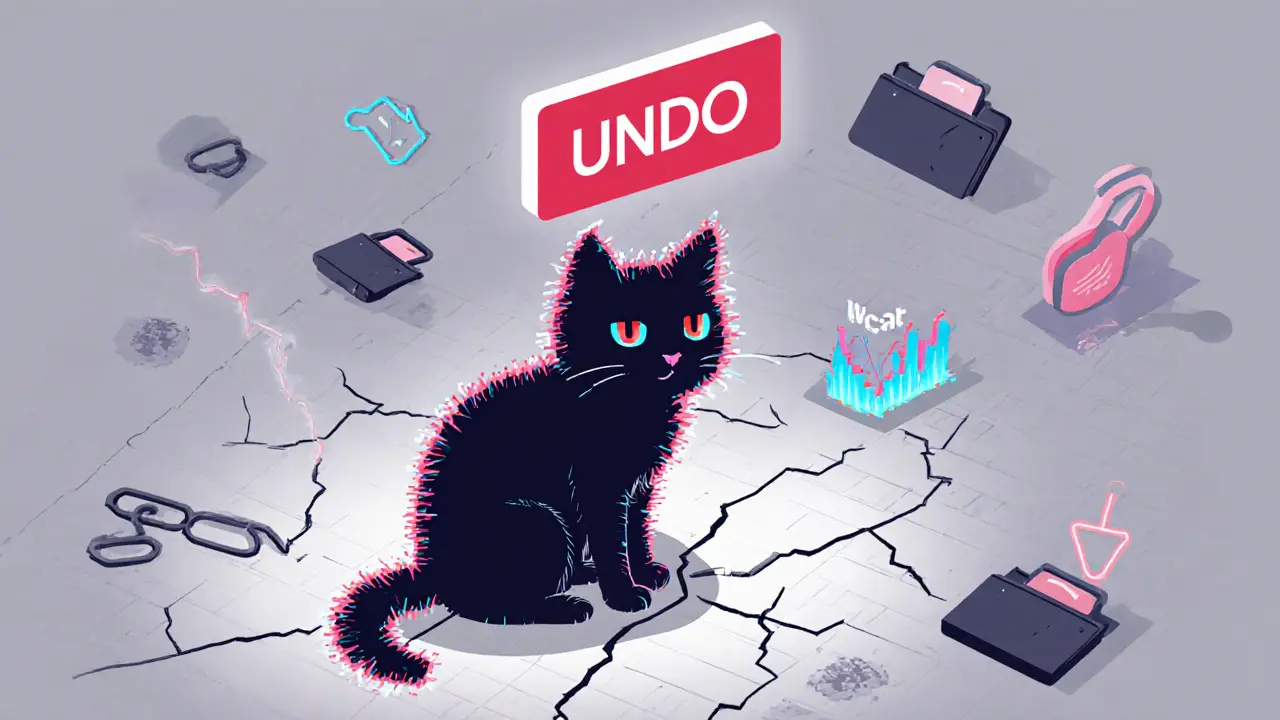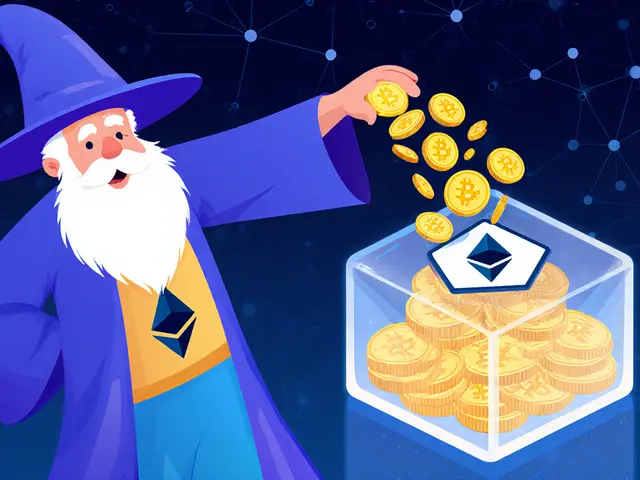SGR Price Calculator
SGR Market Snapshot
Peak Price: $3.70 (March 2024)
Current Price: $0.33 (October 2025)
Price Drop: 90.5% from peak
Supply: 21 million total, 1.47 million in circulation
24h Volume: $18,000
Important: The price drop of 90% shows significant volatility. Remember that most of the supply (19.53 million tokens) is locked and not in circulation, making the actual market cap figures vary widely between platforms.
Investment Results
If you invested $0.00 at Peak Price:
$0.00
This represents a 0% change from your initial investment.
Warning: This calculator is for informational purposes only. SGR has shown extreme volatility with a 90.5% drop from its peak price. The project lacks transparency with its development team and AI claims. This is not investment advice.
Most crypto coins are just numbers on a blockchain - but Schrödinger (SGR) tries to be something else entirely. It’s not just a currency. It’s not even just an NFT. It’s meant to be a living digital creature that changes over time, shaped by AI and community actions. The idea sounds like science fiction: a token that acts like a cat in a box - both alive and dead until you look at it. That’s where the name comes from. But in reality, Schrödinger (SGR) is a real token launched in March 2024, and it’s already had its highs, lows, and plenty of confusion.
What Exactly Is Schrödinger (SGR)?
Schrödinger (SGR) is the native token of the Schrödinger’s Cat Project, an NFT collection that blends artificial intelligence with digital art. Unlike regular NFTs that sit still on a blockchain, these NFTs are designed to evolve. They change based on algorithms, user interactions, and even random events inside the system. The token, SGR, is what you use to mint new cats, upgrade them, or undo mistakes - yes, you can actually reverse a transaction if you mess up.
Technically, SGR runs on Ethereum as an ERC-20 token. Its smart contract address is 0x478156DeAbfAc918369044D52A6BdB5Cc5597994. But here’s the twist: CoinMarketCap lists it under an experimental standard called ACS-404. This isn’t a real blockchain standard like ERC-20 or ERC-721. It’s a label the project uses to describe a hybrid system that tries to combine features of multiple token types. Think of it as a car that claims to be part motorcycle, part airplane, and part boat - it’s trying to do too much at once, and the tech isn’t fully proven yet.
Supply, Price, and Market Data
The total supply of SGR is fixed at 21 million tokens. That’s the same as Bitcoin’s cap - a nice touch for marketing, but misleading. Only about 1.47 million SGR tokens are actually in circulation right now. The rest are locked up, either in team wallets, reserved for future sales, or waiting to be released through staking or rewards. That’s a big red flag for anyone looking at market cap numbers.
When it launched in March 2024, SGR hit an all-time high of $3.70. That was short-lived. By the end of the day, it crashed to $0.22. Since then, it’s been a slow decline. As of October 2025, it trades around $0.33. That’s down over 90% from its peak. Market cap figures vary wildly between platforms - some say $6.8 million, others say $634,000. That kind of inconsistency usually means low liquidity and thin trading volume. The 24-hour trading volume hovers around $18,000, which is tiny compared to even the smallest mainstream coins.
Looking at the yearly chart, SGR is down 75%. The 24-hour price changes are barely noticeable - sometimes up 0.1%, sometimes down 0.2%. This isn’t a volatile coin anymore. It’s a quiet one. And quiet coins with low volume rarely recover unless something big happens.

How Does the AI System Work?
This is where Schrödinger tries to stand out - and where it’s hardest to verify anything.
The project claims its NFTs use AI to evolve. That means your digital cat could change its appearance, traits, or abilities based on how often it’s traded, how many people interact with it, or even what other NFTs it’s near in the digital space. There’s also an “undo” feature: if you accidentally sell your cat or evolve it wrong, you can reverse the action. That’s unique. No other NFT project offers that.
But here’s the problem: no one has shown real proof. There are no public dashboards showing how many cats have evolved, what traits changed, or how often the AI triggers updates. No developer updates. No GitHub commits. No blog posts explaining the machine learning models behind it. The whole thing feels like a pitch deck with no code behind it.
Compare that to projects like Art Blocks or CryptoPunks, where every change is transparent and verifiable. Schrödinger’s Cat Project? It’s all promises. And in crypto, promises without proof are just noise.
Who’s Behind It?
There’s no public team. No LinkedIn profiles. No Twitter accounts with verified badges. No whitepaper with names. The project’s website is clean, modern, and full of buzzwords - “dynamic digital assets,” “emergent properties,” “creator platform for the future.” But there’s zero information about who built it, where they’re from, or what their track record is.
That’s a huge risk. Most successful crypto projects have at least one known founder with a history in tech or blockchain. Schrödinger has none. That makes it hard to trust. If the team vanishes tomorrow, the entire AI system could stop working. The NFTs would freeze. The “undo” feature would break. And you’d be left with a digital cat that can’t change, can’t evolve, and can’t be sold easily because no one’s trading it.

Is It Worth Buying?
Some price prediction sites say SGR could hit $0.94 by the end of 2025. That sounds great - almost 200% gain. But those predictions are based on nothing but guesses. They don’t account for lack of adoption, no real development, or the fact that 90% of the supply is locked up.
Here’s the reality check: if you’re looking to invest in something with long-term potential, SGR isn’t it. The market has already spoken - it’s not interested. The price has collapsed. The volume is tiny. The team is invisible. The AI claims are unverified.
But if you’re just curious - if you want to own a weird experiment in crypto history - then maybe buy a small amount. Treat it like a collectible, not an investment. Buy one or two cats. See if they change. Watch the community. See if anyone ever posts proof of evolution. If nothing happens by mid-2026, walk away. Don’t double down.
What’s the Bigger Picture?
Schrödinger’s Cat Project is trying to solve a real problem: static NFTs are boring. Digital art that never changes doesn’t hold attention. The idea of AI-powered, evolving NFTs is exciting. And if someone could actually make it work - with real code, real data, and real users - it could change the whole NFT space.
But Schrödinger isn’t that someone. Not yet. Maybe in five years, a better version of this idea will come along. Maybe a team with real experience will build a platform where NFTs learn from users, adapt to trends, and become truly alive. But right now? SGR is a prototype that never got tested.
The future of NFTs isn’t in gimmicks. It’s in utility. In games. In real-world use cases. Schrödinger might be a cool idea, but unless it delivers something tangible, it’ll just be another footnote in crypto’s long list of failed experiments.
Is Schrödinger (SGR) built on Ethereum?
Yes, SGR is officially an ERC-20 token on the Ethereum blockchain, with a smart contract address of 0x478156DeAbfAc918369044D52A6BdB5Cc5597994. However, CoinMarketCap lists it under an experimental standard called ACS-404, which claims to combine features of ERC-20, ERC-721, and ERC-1155. This creates confusion, but Ethereum remains the primary chain.
What is the total supply of SGR?
The total supply of Schrödinger (SGR) is fixed at 21,000,000 tokens. However, only about 1.47 million are currently in circulation. The rest are locked in team wallets, future sales, or staking pools, which means the actual market supply is much smaller than the full supply suggests.
Can I really undo an NFT transaction with SGR?
Yes, according to the project, SGR includes an “undo functionality” that lets users reverse actions like minting, evolving, or trading NFTs. This feature is unique and designed to reduce buyer regret. However, there’s no public proof that this system works reliably. No transaction logs or user testimonials confirm it’s been tested at scale.
Why is the price of SGR so low now?
Schrödinger (SGR) peaked at $3.70 in March 2024 and has since dropped over 90%. The crash happened because the hype faded quickly, trading volume stayed low, and no real progress was shown on the AI or NFT evolution features. Without ongoing development, community growth, or transparent updates, investors lost interest.
Is Schrödinger (SGR) a scam?
It’s not confirmed as a scam, but it has all the warning signs: anonymous team, no code transparency, unverified AI claims, and a massive price drop. It’s more accurate to call it a high-risk experiment that hasn’t delivered on its promises. Don’t invest money you can’t afford to lose.
Where can I buy SGR?
Schrödinger (SGR) is listed on a few smaller decentralized exchanges like Uniswap and PancakeSwap. You’ll need Ethereum or BNB to trade for it. Be cautious - low liquidity means you might not get the price you expect when selling. Always check the contract address before trading to avoid fake tokens.







Comments (12)